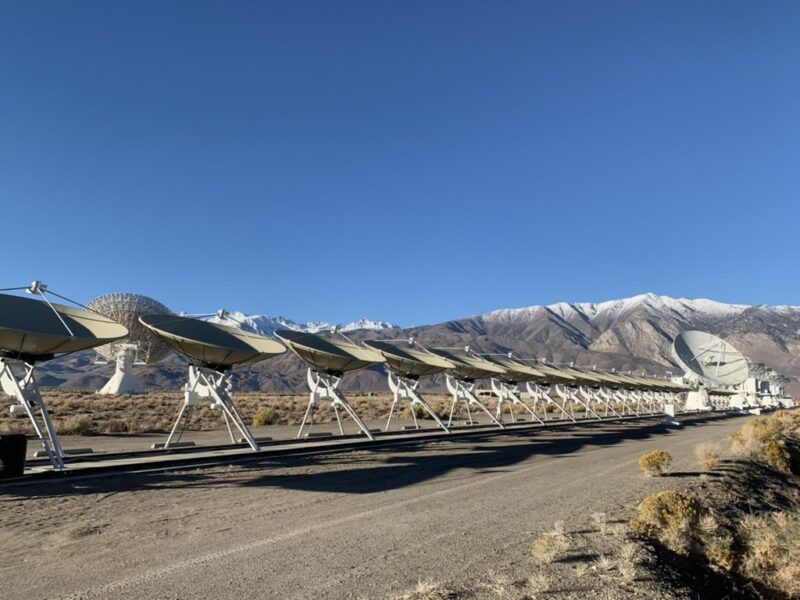From - Sky & Telescope,
By- Govert Schilling,
Edited by - Amal Udawatta,
An illustration of a radio signal from a fast radio burst as it moves toward telescopes on Earth.
J. Josephides / Swinburne University of Technology, Australia, with minor modifications by the Dunlap InstituteFlashes of radio waves — whose exact sources are still a bit of a mystery — are helping astronomers learn about the hot gas that surrounds the Milky Way
Nobody knows the true nature of fast radio bursts (FRBs). Nevertheless, these ultra-short flashes of radio waves are starting to shed light on the structure of galaxies and the evolution of the universe. As the bursts traverse deep space, astronomers learn about the cosmic distribution of tenuous ionized gas — a plasma consisting of atomic nuclei and free electrons — that is almost impossible to observe directly.
“Astronomers love a good mystery — what are FRBs? — but the wider impact of FRBs on astrophysics will definitely be through their application as unique probes of the dark baryonic universe,” says Ziggy Pleunis (University of Toronto). Dark baryons aren’t the same as dark matter, they’re simply the hot, and therefore nearly invisible gaseous ions that surround galaxies and permeate intergalactic space.
Pleunis is part of a large and mainly Canadian team of astronomers that is studying fast radio bursts with the Canadian Hydrogen Intensity Mapping Experiment (CHIME) telescope in British Columbia. A detailed analysis of 93 FRBs discovered with CHIME, published in The Astrophysical Journal, suggests that the halo of our own Milky Way galaxy contains less baryonic matter than most galaxy evolution models predict.
FRBs are most likely energetic explosions on or near strongly magnetized neutron stars in faraway galaxies, and they emit radio waves at a wide range of frequencies. These waves slow down ever so slightly as they interact with plasma between the distant explosion and Earth, with higher-frequency waves slowing more than their lower-frequency counterparts. As a result, the bursts – which usually last no more than a millisecond or so – are smeared out over time. This dispersion measure is larger if there is more intervening plasma.
Thus, astronomers can use FRBs as searchlights to shine through the gas in between and around galaxies. “Each FRB gives us a measurement of the Milky Way halo in one direction, so as we continue to collect them, we can build up a detailed picture,” explains team lead Amanda Cook (University of Toronto) in a press statement.
The team’s analysis appears to confirm an earlier result based on just one FRB, observed with the Deep Synoptic Array-110 observatory under construction in California, and presented at the American Astronomical Society meeting in Seattle by Vikram Ravi (Caltech). At the time, Ravi explained the discrepancy between observations and theory by suggesting that the Milky Way’s halo might have lost baryonic matter over time. Supernova explosions and strong stellar winds might have tossed the gas beyond our galaxy’s gravitational reach.

Caltech/Owens Valley Radio Observatory
Meanwhile, an international team led by Joeri van Leeuwen (ASTRON) has bagged five telltale FRBs with the recently upgraded Westerbork observatory in the Netherlands. This 53-year-old array contains 14 dishes, each one 25 meters (82 feet) across. Thanks to new Apertif receivers (Aperture Tile In Focus) that were installed over the past few years, both the field of view and the spatial resolution of the Westerbork array has increased substantially. According to Van Leeuwen, Westerbork is now discovering about one FRB per week.
As the team describes April 12th in Astronomy & Astrophysics, three of the five Westerbork bursts occurred close to the Triangulum Galaxy (M33) on the sky. Their radio waves pierced the halo of this nearby spiral galaxy, as well as the extended halo of the Andromeda galaxy (M31), which is even closer.
In principle, the dispersion measures of the three bursts should provide information on the baryonic matter density of the M33 and M31 halos, but the analysis is complicated: at least part of the observed dispersion is due to our own galaxy, and both the burst’s host galaxy and all the plasma along the way leave their fingerprints, too. Disentangling the various contributions isn’t easy, but Pleunis says, “This information is essential for a better understanding of galaxy formation and evolution.”
In the near future, astronomers expect to discover many more fast radio bursts and to pinpoint them precisely to their remote host galaxies. Measuring the redshift in the host galaxy’s light then yields the burst’s distance. Eventually, the resulting 3D network of FRB searchlights should enable a form of cosmic tomography, revealing the distribution of ionized gas through space and time. Van Leeuwen, for one, is optimistic: “I’m won over,” he says. “FRB cosmology is the future.”

Comments
Post a Comment